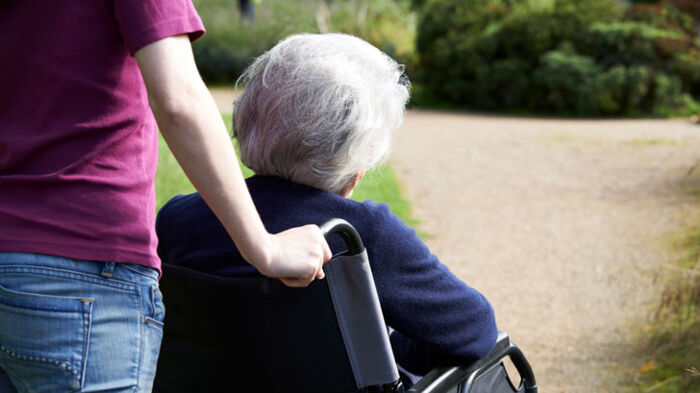The high price of being a full-time carer
By Susan Hely
When my friend Janice found out her mother, Kay, had been in a bad car accident, she didn't realise the enormous impact it would have on both their lives.
Kay, a widow, couldn't look after herself without round-the-clock assistance. Janice was still working and tried to manage her mother's care needs with part-time support. She took her paid carer's leave entitlements at work and then leave without pay.
But eventually Janice quit her job to become Kay's primary carer.
On the one hand it was an agonising decision to make because Janice likes her job and the income it provides. But as an empathetic and devoted daughter, she knew it was a time to support her mother and she didn't want the 60-year-old in a care home during the COVID outbreaks.
At first Janice hoped her mother would come good and be able to care for herself so she could return to full-time work.
Janice finds caring for her mum all-consuming, with many challenges, but she doesn't want to hand it over to anyone else. She is an advocate for her mum, making sure she receives the right medical care, monitoring her medicines and liaising with doctors and therapists.
Janice has taken on flexible part-time work from home, but earns less - about half of what she earned before. She feels cut off from people, has a limited social life and doesn't see a way out of her caring role because of Kay's limited mobility. Janice worries that her future earnings won't get back to where they once were and is facing poverty in old age.
Impact on lifetime earnings
Of the 2.65 million carers in Australia, about 861,000 are primary carers and approximately 72% are women. A third of carers of older people are daughters like Janice.
Thirty-four per cent of older people are only supported by informal carers. Of those living with a disability, 42% don't receive formal assistance for their needs and rely on family members and other informal carers, according to Carers Australia.
The age at which a person becomes a carer and interrupts their career not only hits their income but their retirement savings, too.
Often informal carers must work or study part-time or become full-time carers. This has a huge impact on their earnings and superannuation, with Carers Australia estimating it reduces lifetime earnings by $39,600 a year.
Also, it devastates an informal carer's retirement savings, reducing their superannuation balances by about $17,700 for every year of their caring role (taking into account the compounding effect).
Carers Australia says lost earnings and superannuation add up to more than $567,000 ($392,000 in wages and $175,000 in super) on average for our 2.65 million carers.
But if you are caring full-time over your lifetime, it is much more.
The most affected carers are those who start very young as full-time carers. They will lose at least $940,000 in lifetime income and $444,500 in superannuation.
In Australia, there are more than 235,000 carers under the age of 25, looking after a parent, partner, sibling, their child, relative or friend.
The federal government paid out $10 billion to informal carers in 2020-21. They may be eligible for benefits for constant care of someone who is living with a disability or a severe medical condition, mental illness, drug or alcohol problem, terminal illness or is a frail, elderly adult.
The government also spent $700 million on respite services through its home support program, home care packages and residential aged care.
There are two sorts of payments: a carer payment and a carer allowance. It is possible to receive both at the same time.
Additional supplements of $600 for each eligible person and $1000 for each child under 16 were paid in July and August to carers.

Benefits available for carers
Carer payment
Around 300,000 people receive a carer payment that is similar to the amount of other income support payments, such as the age pension and the disability support pension. The carer payment is subject to income and assets tests.
A single carer can be paid up to a maximum of $1026.50 a fortnight while a couple can earn $1547.60 or $773.80 each.
You can work or study up to 25 hours a week away from the person you care for and still get the payment. But earning an income could reduce the amount of assistance you receive.
The amount of the payment considers whether you are in a relationship and whether or not you are a homeowner.
Carer allowance
Around 623,000 Australians receive a carer allowance. There's no assets test for the carer to claim this $136.50 a fortnight if you are providing care for someone who is over 16 but there is an income limit of $250,000 per household.
If you are sharing the care with someone else, you can split the carer payment and receive an amount based on how much care you provide. If you are giving additional daily care and attention to someone because they have either a disability or severe illness or are old and frail, you qualify.
Respite care
You can use 63 days of respite care each calendar year if you get the carer payment or carer allowance.
State government support
Some states and territories offer extra support for carers, including counselling and respite care.
Personal and carer leave entitlements
Full-time employees receive 10 days each year of paid sick leave and carer's leave. Part-time workers receive a pro rata 10 days each year.
Unpaid carer's leave
An employee is entitled to two days of unpaid carer's leave for each occasion when an immediate family member requires care or support because of a personal illness, injury or unexpected emergency.
Carer Gateway
Phone 1800 422 737 or visit carergateway.gov.au for this government-run program, which provides emotional, practical and financial support to carers. All unpaid carers, including carers who are not receiving government benefits can use this service.
Emergency respite care is available through Carer Gateway for eligible carers who are ill or injured and can't look after the person they are caring for.
It offers an online community forum for carers to share advice and ask questions; there are also local peer support groups for carers to meet other carers.
Carer Gateway also offers face-to-face and online counselling and coaching services as well as skills courses, which include understanding of the legal responsibilities of a caring role.
Travel and transport help
The person you care for may qualify for a mobility allowance to help them with travel costs.
Get stories like this in our newsletters.



